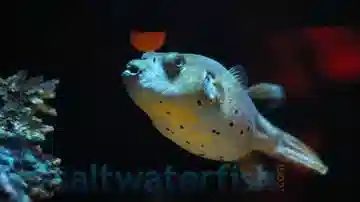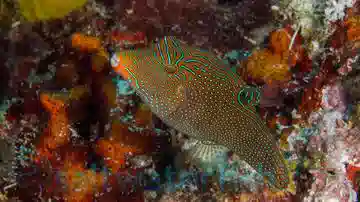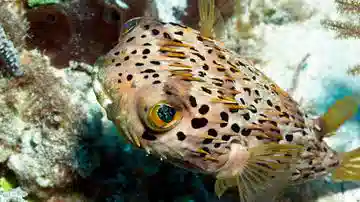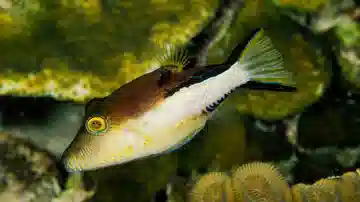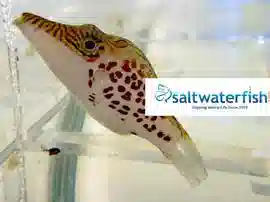Leopard Puffer
Canthigaster leoparda
(2 Reviews)
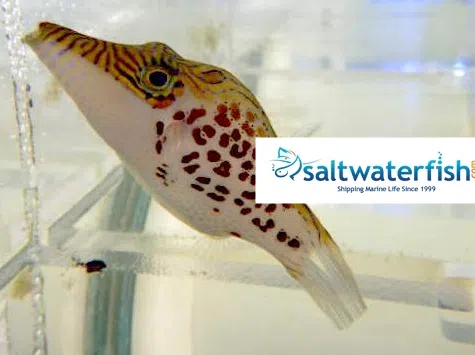
Leopard Puffer
Canthigaster leoparda
(2 Reviews)
{{ item.name }}
Size: {{ item.extra_field_3 }}
${{ getFormattedPrice(item.saleprice) }} ${{ getFormattedPrice(item.price) }}
To join the waiting list, click here
Free Shipping
With
$199.00
or more in Marine Life.
More details...
Leopard Puffer Care Facts
| Care Level: | Easy |
|---|---|
| Temperament: | Semi-Aggressive |
| Diet: | Carnivore |
| Reef Safe: | No |
| Minimum Tank Size: | 30 gallons |
| Max Size: | 3 inches |
The Leopard Puffer, Canthigaster leoparda, or the Leopard Toby Puffer, is a small, but brilliantly colorful and patterned puffer fish. A mosaic of spots, stripes, and color, the Leopard Puffer uses its fins to move graceful around the aquarium. The Leopard Puffer, like other puffers, have the unique ability to puff out, especially when it feels trapped in a net. Therefore, it is recommended that the Leopard Puffer should be transferred using a container, and not a net. Multiple puffers can be kept in one tank but should have at least 30 gallons for each individual. The Leopard Puffer thrives best in fish-only tanks and are not recommended to be housed with small invertebrates and should be monitored extremely closely with most corals. The Leopard Puffer should be fed meaty foods, preferably a variegated diet including clams, shrimp, frozen foods, hard shelled shrimp and herbivorous foods.
Leopard Puffer (Canthigaster leoparda) for Saltwater Marine Aquariums
This comprehensive analysis delves into the practical aspects of keeping the Leopard Puffer (Canthigaster leoparda) in saltwater marine aquariums. An educational and formal examination, it provides vital insights into the habitat, care requirements, and reasons for selecting the Leopard Puffer from Saltwaterfish.com.
Habitat and Reef Compatibility of the Leopard Puffer
The Leopard Puffer is indigenous to the Indo-Pacific region, where it dwells in coral reefs and adjacent sandy areas. In terms of reef compatibility, exercise caution. Leopard Puffers may exhibit a penchant for nipping at and potentially damaging coral formations. Thus, they are often recommended for fish-only or FOWLR (Fish Only With Live Rock) setups.
Size and Lifespan of the Leopard Puffer
Leopard Puffers typically attain a size of 3 to 4 inches in captivity, making them suitable for smaller aquariums. They boast a lifespan of 5 to 10 years when provided with optimal care conditions.
Diet in Captivity
In the wild, Leopard Puffers primarily feed on small crustaceans, mollusks, and various invertebrates. In a captive environment, they readily accept a diet comprising high-quality pellet or flake foods supplemented with frozen or live offerings such as brine shrimp and mysis shrimp. Providing a varied diet is essential to ensure they receive the necessary nutrients.
Aquaculture and Availability
Currently, Leopard Puffers are not widely aquacultured, resulting in a reliance on responsibly sourced wild specimens. Saltwaterfish.com prioritizes ethical collection practices, ensuring the availability of healthy and well-acclimated Leopard Puffers for hobbyists.
Compatibility with Other Fish and Invertebrates
Leopard Puffers are generally considered peaceful and can be kept alongside a variety of compatible tank mates. Suitable tank mates include:
- Clownfish (Amphiprion spp.): Their size and temperament make them suitable companions.
- Firefish (Nemateleotris spp.): Peaceful fish that coexist well with Leopard Puffers.
- Royal Gramma (Gramma loreto): A small, non-aggressive fish that complements Leopard Puffers.
- Damsels (Chromis spp.): Some species of damsels can cohabit harmoniously.
Sexual Dimorphism
Leopard Puffers do not exhibit sexual dimorphism, making it challenging to visually distinguish between males and females.
Temperament
Leopard Puffers are known for their generally peaceful and non-aggressive nature. However, like many puffers, they may display territorial behavior if they feel cramped or threatened. Providing ample hiding places and sufficient space can help mitigate territorial issues.
Tank Requirements for the Leopard Puffer
To create a suitable habitat for Leopard Puffers, consider the following tank requirements:
- Minimum Aquarium Size: A tank with a capacity of 30 gallons or more is suitable for Leopard Puffers, given their smaller size.
- Substrate: Use fine sand as a substrate to mimic their natural habitat.
- Decor: Incorporate live rock structures and caves for hiding.
- Lid or Cover: Ensure a secure lid or cover to prevent escapes, as puffers are known for their ability to jump.
Detailed Water Conditions
- pH: Keep the pH level stable between 8.1 and 8.4 to support metabolic functions and overall health.
- Salinity: Maintain a salinity level within the range of 1.020 to 1.025 specific gravity, reflecting the conditions in their native habitat.
- Water Temperature: Maintain a stable water temperature between 75°F and 82°F (23.9°C to 27.8°C) to ensure their comfort.
- Water Flow: Provide moderate water flow to simulate their natural environment.
Why Choose the Leopard Puffer from Saltwaterfish.com
Selecting the Leopard Puffer from Saltwaterfish.com guarantees access to responsibly sourced and expertly shipped specimens. Saltwaterfish.com's commitment to sustainable collection practices ensures that hobbyists receive healthy and well-adjusted Leopard Puffers. By choosing the Leopard Puffer from Saltwaterfish.com, enthusiasts support ethical marine trade and have the privilege of hosting this charming species in their saltwater marine aquariums.
Reviewed by: Tammy Bahrs on Dec. 4, 2023
Very good Leopard Puffer for your tank. I have lost this species and don't know why. Purchased a new one which just arrived.
Reviewed by: Brian Dogith on Jan. 1, 2022


